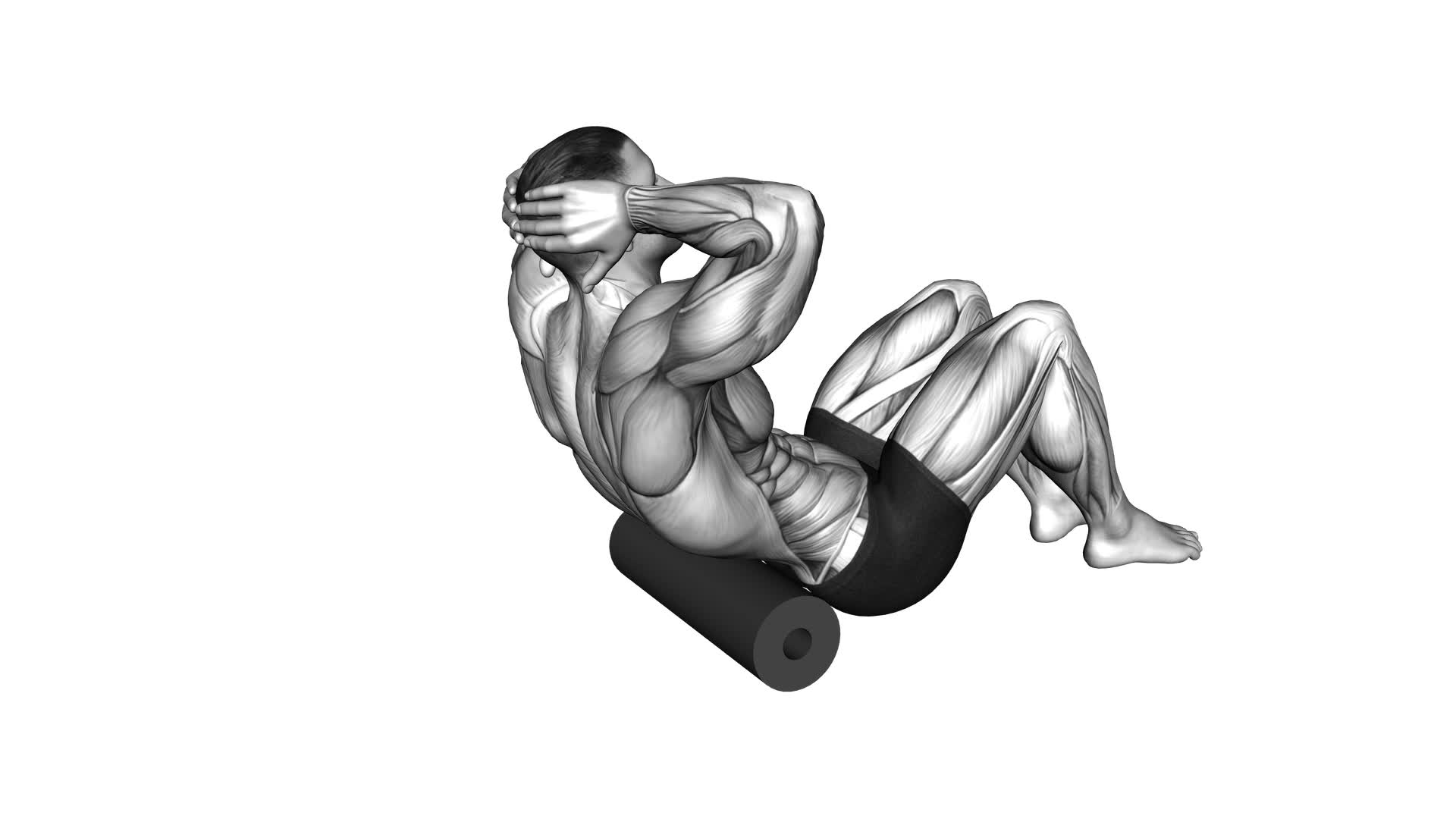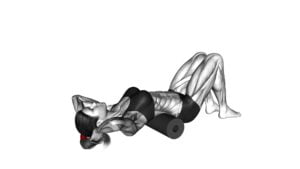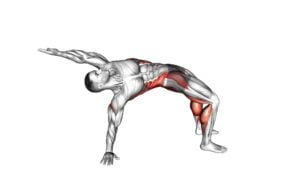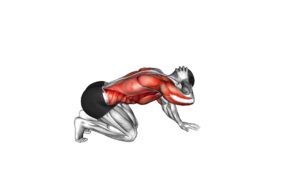Roll Thoracic Spine Lying on Floor – Video Exercise Guide & Tips

Get ready to relieve tension and improve your posture with the Roll Thoracic Spine exercise.
Watch This Exercise Video
In this video exercise guide, we'll show you step-by-step how to perform this effective exercise. You'll only need a floor and a few minutes of your time.
Avoid common mistakes and enhance the effectiveness of this exercise with our expert tips. Whether you're a beginner or advanced, we've got modifications and variations for all fitness levels.
Say goodbye to aches and pains – let's get rolling!
Key Takeaways
- The roll thoracic spine exercise improves flexibility in the upper body and increases mobility and reduces stiffness in the thoracic spine.
- This exercise also improves posture and decreases the risk of injuries, as well as supports the upper body and protects vital organs.
- Proper form, engaging the core, and deep breathing are essential for maximizing the benefits of the roll thoracic spine exercise.
- Gradual progression and modifications based on individual needs and abilities are important for building strength and flexibility in this exercise.
Benefits of the Roll Thoracic Spine Exercise
To maximize the benefits of the Roll Thoracic Spine exercise, position yourself on the floor between two foam rollers.
This exercise offers numerous benefits for both flexibility and thoracic spine health. Flexibility is crucial for maintaining a full range of motion in your upper body, and the Roll Thoracic Spine exercise helps to improve this flexibility.
By targeting the thoracic spine, which is the area between the neck and lower back, this exercise helps to increase the mobility of the spine and reduce stiffness. This leads to improved posture and decreased risk of injuries.
Additionally, a healthy thoracic spine is essential for optimal overall health. It plays a key role in supporting the upper body, protecting the vital organs, and facilitating proper breathing.
By incorporating the Roll Thoracic Spine exercise into your routine, you can enhance the health of your thoracic spine, leading to improved overall well-being.
Equipment Needed for the Exercise
To effectively perform the Roll Thoracic Spine exercise, there are a few essential pieces of equipment you'll need.
Firstly, you'll need a yoga mat or a comfortable surface to lie on.
Additionally, a foam roller is crucial for this exercise, as it helps to target and mobilize the thoracic spine. If you don't have a foam roller, you can use a rolled-up towel or a tennis ball as alternatives.
Lastly, it's important to ensure that you have enough space around you to perform the exercise safely and without any obstructions.
Essential Equipment for Exercise
You will need three essential pieces of equipment for this exercise.
The first piece of equipment is a foam roller. A foam roller is a cylindrical tool made of dense foam that can help improve flexibility, increase blood flow, and alleviate muscle soreness. It's a cost-effective exercise equipment alternative that can provide similar benefits to a professional massage.
The second piece of equipment is a yoga mat. A yoga mat provides cushioning and support for your body as you perform the exercise on the floor. It also helps prevent slipping and provides stability.
The third piece of equipment is a towel. A towel can be rolled up and used as a prop to support your neck and head during the exercise.
Now let's explore some alternatives to costly equipment that you can use for this exercise.
Alternatives to Costly Equipment
For this exercise, you'll need alternatives to the costly equipment mentioned earlier. Luckily, there are several cost-effective options and affordable alternatives that can be used instead.
Here are some suggestions:
- Foam Roller:
- Use a rolled-up towel or a firm pillow to mimic the effects of a foam roller. Place it under your thoracic spine and gently roll back and forth.
- Another option is to use a tennis ball or a lacrosse ball. Place it against a wall and lean your back into it, targeting specific areas of tension.
- Resistance Band:
- If you don't have a resistance band, a long towel or a scarf can be used as a substitute. Simply tie it around a sturdy object and use it for resistance exercises.
Safety Precautions and Equipment
Now let's continue with the topic of safety precautions and the equipment needed for this exercise.
When performing the roll thoracic spine lying on the floor exercise, it's important to prioritize injury prevention and maintain proper form throughout the movement.
To ensure safety, it's recommended to have a yoga mat or a comfortable surface to lie on. This will provide cushioning and support for your back. Additionally, a small towel or foam roller can be used to support the neck and maintain proper alignment.
It's crucial to listen to your body and avoid any movements that cause discomfort or pain. Remember to engage your core muscles and keep your movements controlled and smooth.
Step-By-Step Guide on How to Perform the Exercise
To perform the roll thoracic spine exercise, it's important to focus on proper body alignment, breath control, and relaxation.
Maintaining a neutral spine position and engaging the core muscles will help protect the back and prevent injury.
Proper Body Alignment
You can achieve proper body alignment by following these step-by-step instructions for performing the Roll Thoracic Spine exercise while lying on the floor:
- Lie flat on your back with your knees bent and feet flat on the floor.
- Place your hands behind your head, interlocking your fingers.
- Keep your elbows wide and relaxed.
Engage your core muscles and lift your shoulders off the floor. Slowly roll your upper body to the right side, aiming to touch your right shoulder to the floor. Hold this position for a few seconds, feeling a stretch along your spine.
Return to the starting position and repeat on the left side. Continue alternating sides for the desired number of repetitions.
Breath Control and Relaxation
Engage your breath control and relaxation while performing the Roll Thoracic Spine exercise by focusing on deep, controlled breathing throughout the movement.
Incorporating proper breathing techniques into your exercise routine can help reduce stress and enhance relaxation. As you begin the exercise, take a deep breath in, filling your lungs completely. As you exhale, focus on releasing any tension in your body and allowing your muscles to relax.
Throughout the movement, continue to breathe deeply and evenly, inhaling as you roll your spine, and exhaling as you return to the starting position. This conscious focus on your breath won't only enhance the effectiveness of the exercise but also promote a sense of calm and relaxation, helping you to reduce stress and tension in your body.
Benefits of Regular Practice
Start by lying on your back on the floor. Regular practice of the roll thoracic spine exercise offers numerous benefits, making it an essential addition to your fitness routine. Here are some advantages of incorporating this exercise into your regular practice:
- Improved flexibility: Rolling your thoracic spine helps to increase the flexibility of your upper back and shoulders, promoting better range of motion in daily activities.
- Enhanced posture: By mobilizing and strengthening the muscles in your upper back, this exercise helps to correct postural imbalances and promotes an upright posture.
- Relief from back pain: Regular practice can alleviate tension and stiffness in the thoracic spine, reducing back pain and discomfort.
- Core activation: The roll thoracic spine exercise engages your core muscles, contributing to a stronger and more stable core.
- Stress reduction: This exercise promotes relaxation and stress relief, helping you to unwind and improve your overall well-being.
By understanding the benefits of regular practice, you can stay motivated and committed to incorporating this exercise into your fitness routine.
Now, let's explore some common mistakes to avoid during the exercise.
Common Mistakes to Avoid During the Exercise
To ensure proper form and maximize the benefits of the exercise, it's important to be mindful of common mistakes to avoid while rolling the thoracic spine lying on the floor.
One common mistake isn't maintaining proper alignment throughout the movement. It's crucial to keep your head, neck, and spine in a straight line throughout the exercise. Avoid tucking your chin or allowing your head to jut forward.
Another mistake to avoid is using excessive force or momentum to roll your spine. This can lead to strain or injury. Instead, focus on using controlled, deliberate movements to roll the spine.
It's also important to avoid rolling too far or too fast. This can put unnecessary stress on the spine and may not allow for proper engagement of the muscles.
Finally, be mindful of any pain or discomfort during the exercise. If you experience any pain, stop immediately and consult with a healthcare professional.
Tips to Enhance the Effectiveness of the Exercise
To maximize the effectiveness of the exercise, use a few simple tips:
- Maintain proper form: Ensure that your body is aligned correctly throughout the exercise. Keep your shoulders back, chest lifted, and neck relaxed. This will help target the thoracic spine and prevent unnecessary strain on other areas of your body.
- Engage your core: By activating your core muscles, you stabilize your spine and enhance the performance of the exercise. Engaging your core will also help you maintain balance and control as you roll your thoracic spine on the floor.
- Breathe deeply: Deep breathing can enhance the effectiveness of the exercise by promoting relaxation and increasing oxygen flow to your muscles. Inhale deeply as you roll your thoracic spine back, and exhale fully as you roll it forward. This will help you maintain control and maximize the benefits of the exercise.
- Progress gradually: Start with small movements and gradually increase the range of motion as your flexibility and strength improve. Pushing yourself too hard too soon can lead to injury and hinder your progress. Take your time and listen to your body.
By following these tips, you can enhance the performance of the exercise and maximize the results.
Remember to always consult with a healthcare professional or a certified fitness instructor before attempting any new exercise routine.
Modifications and Variations for Different Fitness Levels
To modify or vary the exercise for different fitness levels, you can make adjustments based on your individual needs and abilities. Exercise modifications allow you to tailor the roll thoracic spine lying on the floor to your specific fitness level, ensuring that you can safely and effectively engage in the exercise.
For beginners or individuals with limited mobility, you can start with a smaller range of motion. Instead of rolling your entire spine, you can focus on a smaller segment, such as the upper or lower back. This modification allows you to gradually build strength and flexibility before progressing to the full roll.
On the other hand, if you're more advanced or looking for an extra challenge, you can increase the difficulty of the exercise. One way to do this is by using a foam roller or a massage ball for added intensity and pressure. This can enhance the stretch and release tension in the thoracic spine.
Additionally, you can modify the speed and tempo of the exercise. Slowing down the movement and holding each position for a longer duration can increase the intensity and provide a deeper stretch. Conversely, increasing the speed can make the exercise more dynamic and engaging.
Frequently Asked Questions
Can the Roll Thoracic Spine Exercise Be Performed by Individuals With Back or Spine Injuries?
If you have back or spine injuries, it's important to consult with a healthcare professional before attempting the roll thoracic spine exercise. They can assess your condition and determine if this exercise is suitable for you.
Back or spine injuries require specific care and caution, and certain exercises may need to be modified or avoided altogether.
Prioritize your safety and listen to the guidance of your healthcare provider to ensure a safe and effective exercise routine.
How Often Should the Roll Thoracic Spine Exercise Be Performed to See Results?
To see results from the roll thoracic spine exercise, it's important to consider the frequency and duration of the exercise.
The frequency refers to how often you should perform the exercise, while the duration refers to how long each session should last.
Finding the right balance is key. Remember to listen to your body and start with a frequency and duration that feels comfortable.
Gradually increase both as your strength and flexibility improve.
Is It Necessary to Warm up Before Doing the Roll Thoracic Spine Exercise?
Before performing the roll thoracic spine exercise, it's important to warm up your body. Warming up helps increase blood flow, improves flexibility, and reduces the risk of injury. You can warm up by doing light cardio exercises or dynamic stretches.
However, if you're short on time, there are alternative exercises that can also help mobilize your thoracic spine, such as cat-camel stretch or foam rolling.
Remember to consult with a professional before starting any new exercise routine.
Can the Roll Thoracic Spine Exercise Help Improve Posture?
The roll thoracic spine exercise is a great way to improve your posture and overall spinal health. By rolling your spine on the floor, you can strengthen the muscles in your mid-back and increase flexibility in your thoracic spine.
This exercise can also help alleviate tension and pain in the upper back and neck. Depending on your fitness level, you can modify this exercise by using a foam roller or adding resistance with weights.
Are There Any Specific Breathing Techniques That Should Be Used During the Roll Thoracic Spine Exercise?
When performing the roll thoracic spine exercise, it's important to focus on your breathing techniques. By inhaling deeply and exhaling fully, you can engage your core muscles and enhance the benefits of this exercise for core strength.
Proper breathing can also help you maintain control and stability throughout the movement. So, remember to breathe deeply and consciously as you roll your thoracic spine on the floor.
This will maximize the effectiveness of the exercise and promote proper posture.
Conclusion
In conclusion, the roll thoracic spine exercise is a beneficial and effective way to improve flexibility and mobility in the upper back.
By following the step-by-step guide and avoiding common mistakes, you can ensure proper execution of the exercise.
Additionally, incorporating modifications and variations will allow individuals of different fitness levels to participate.
Remember to stay consistent and consult with a professional if you have any concerns or questions.
Keep rolling and enjoy the benefits of a healthier thoracic spine!

Author
Years ago, the spark of my life’s passion ignited in my mind the moment I stepped into the local gym for the first time. The inaugural bead of perspiration, the initial endeavor, the very first surge of endorphins, and a sense of pride that washed over me post-workout marked the beginning of my deep-seated interest in strength sports, fitness, and sports nutrition. This very curiosity blossomed rapidly into a profound fascination, propelling me to earn a Master’s degree in Physical Education from the Academy of Physical Education in Krakow, followed by a Sports Manager diploma from the Jagiellonian University. My journey of growth led me to gain more specialized qualifications, such as being a certified personal trainer with a focus on sports dietetics, a lifeguard, and an instructor for wellness and corrective gymnastics. Theoretical knowledge paired seamlessly with practical experience, reinforcing my belief that the transformation of individuals under my guidance was also a reflection of my personal growth. This belief holds true even today. Each day, I strive to push the boundaries and explore new realms. These realms gently elevate me to greater heights. The unique combination of passion for my field and the continuous quest for growth fuels my drive to break new ground.







